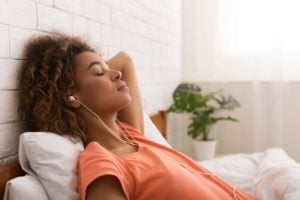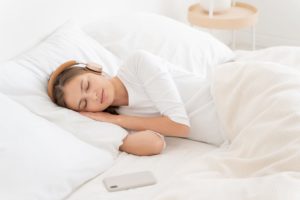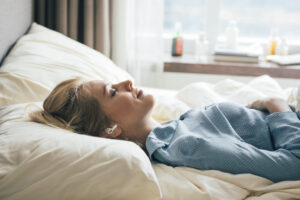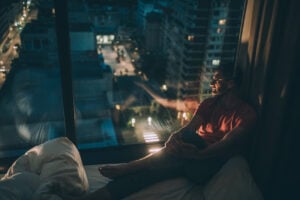When you buy through our links, we may earn a commission. Products or services may be offered by an affiliated entity. Learn more.
Can Binaural Beats Help You Fall Asleep?
- Binaural beats are not a sound but an auditory phenomenon that occurs when listening to two different frequencies at once.
- When binaural beats are sustained for a length of time, they can alter your brain wave activity.
- Evidence on their effectiveness to promote relaxation and improve sleep is limited and results vary.
How do you relax before you fall asleep? Maybe you follow a guided meditation, or perhaps you listen to a podcast or peaceful music. Another possible auditory strategy is listening to binaural beats as you drift off to sleep.
Binaural beats aren’t a music genre. They are an auditory phenomenon created by your brain in response to hearing specific tones in each ear. Early research of the experimental treatment indicates that listening to binaural beats can reduce feelings of anxiety and improve your ability to fall asleep.
What Are Binaural Beats?
Binaural beats are a perception of sound created by your brain. If you listen to two tones, each at a different frequency and each in a different ear, your brain creates an additional tone you can hear. This third tone is called a binaural beat. You hear it at the frequency difference between the two tones.
For example, if you listen to one tone at 300 hertz (Hz) and the other tone at 310 Hz, the binaural beat you hear is at 10 Hz. The binaural beat can be heard if the frequency of each tone in your ears is less than 1000 Hz and the difference between the two tones is less than 35 Hz.
How Do Binaural Beats Work?
When each ear hears a tone at a slightly different frequency, your brain tries to compensate by creating the perception of a third sound. This creation of a third sound is caused by the same part of the brain that helps you determine the location of a sound. To hear the binaural beat, you must have sound coming in each ear. If you take out one of your earbuds, you’ll no longer hear the binaural beat.
When binaural beats are sustained over a period of time, they can synchronize with your brain waves. As a result, binaural beats can alter your brain wave activity as well as your levels of arousal.
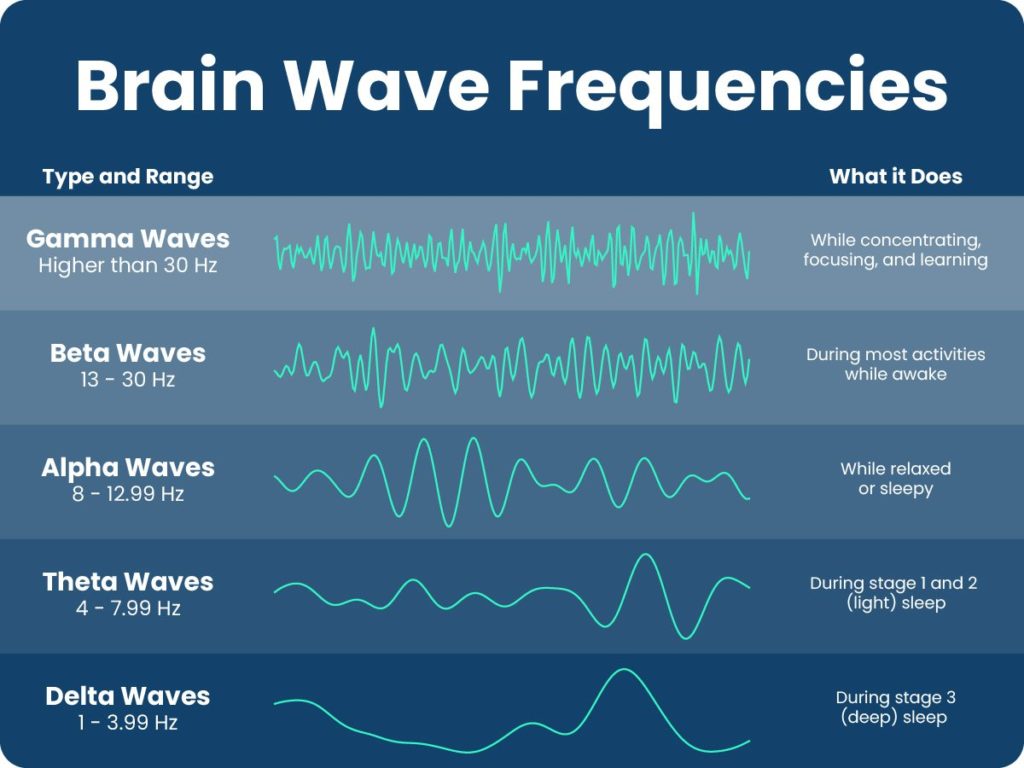
What Can Binaural Beats Do?
Binaural beats can be created at different frequencies. Each frequency is associated with outcomes that correspond to different levels of brain wave activity .
- Gamma (γ) pattern: Gamma waves are the highest frequency of brain activity between 30 Hz and 50 Hz . This type of brain activity is associated with alertness, concentration, and problem solving. A small study found that people listening to binaural beats at gamma frequencies of 40 Hz experienced improved memory , cognition, and even mood.
- Beta (β) pattern: Beta waves range between 13 Hz and 30 Hz. These waves in the brain are linked to an active and alert mind. Higher levels of beta waves are also associated with anxiety. Listening to binaural beats in the beta wave pattern has been shown to improve mood and task performance . Other research has shown that listening to binaural beats at 15 Hz improves memory and accuracy .
- Alpha (α) pattern: Ranging between 8 Hz and 13 Hz, alpha waves indicate a relaxed and restful mind. Research shows that binaural beat stimulation in the alpha range can increase creativity in some listeners.
- Theta (θ) pattern: During stage one of sleep, which is the lightest stage of sleep, your brain produces theta waves at a frequency between 4 Hz and 8 Hz. Theta waves are also associated with drowsiness and meditation. Studies show that listening to binaural beats at a 6 Hz frequency can induce a meditative state .
- Delta (δ) pattern: The slowest brain waves are delta waves. These waves have a frequency under 4 Hz. As you transition into deeper sleep stages, your brain switches from theta waves to delta waves. Dreaming can occur. Listening to binaural beats at delta frequencies can help you sleep.
Can Binaural Beats Help You Sleep Better?
Preliminary research suggests that binaural beats can help you sleep better. A study using binaural beats at a delta frequency of 3 Hz showed that these beats induced delta activity in the brain. As a result, the use of binaural beats lengthened stage three sleep. Stage three sleep is deep sleep and important for feeling refreshed in the morning.
Other small studies indicate the potential of binaural beats for better sleep. In study of soccer players listening to binaural beats ranging from 2 Hz to 8 Hz, players reported improved quality of sleep , less sleepiness, and increased ease of waking up. Binaural beats can also help reduce anxiety , which can then lead to improved sleep.
On the other hand, some researchers have argued there is insufficient evidence linking binaural beats with lessened anxiety or improved sleep. Further research of binaural beats, particularly their effects on sleep, must be conducted.
How Do I Use Binaural Beats?
If you decide to use binaural beats in hopes of improving sleep, there are numerous binaural beat tracks available online. You can also purchase CDs or audio files featuring binaural beats. Oftentimes, these tracks have white noise or other gentle sounds to help you relax. Choose tracks designed for sleep, which are typically beats at theta or delta frequencies.
The length of binaural beat tracks vary. You may need to experiment with multiple listenings to determine how long of a track you need to induce sleepiness.
When listening to binaural beats, make sure you have sound entering each ear. You can wear headphones or earbuds, whichever is more comfortable. If you lose sound in one ear, you will not hear the binaural beats created independently by the brain.
Are There Any Side Effects to Using Binaural Beats?
Currently, only a few negative side effects of using binaural beats have been reported. Some listeners report irritability or frustration while listening to the beats. To prevent this discomfort, researchers suggest tracks with additional sounds, such as white noise.
Additionally, long-term exposure to sound at 85 decibels or higher can result in hearing loss. Examples of everyday sounds at that level or above are motorcycles, concerts, sporting events, and listening to music at full volume through headphones. As you listen to binaural beats, be sure the volume is not too high.

Still have questions? Ask our community!
Join our Sleep Care Community — a trusted hub of sleep health professionals, product specialists, and people just like you. Whether you need expert sleep advice for your insomnia or you’re searching for the perfect mattress, we’ve got you covered. Get personalized guidance from the experts who know sleep best.
References
13 Sources
-
Padmanabhan, R., Hildreth, A. J., & Laws, D. (2005). A prospective, randomised, controlled study examining binaural beat audio and pre-operative anxiety in patients undergoing general anaesthesia for day case surgery. Anaesthesia, 60(9), 874–877.
https://pubmed.ncbi.nlm.nih.gov/16115248/ -
López-Caballero, F., & Escera, C. (2017). Binaural beat: A failure to enhance EEG power and emotional arousal. Frontiers in Human Neuroscience, 11, 557.
https://pubmed.ncbi.nlm.nih.gov/29187819/ -
Chaieb, L., Wilpert, E. C., Reber, T. P., & Fell, J. (2015). Auditory beat stimulation and its effects on cognition and mood states. Frontiers in Psychiatry, 6, 70.
https://pubmed.ncbi.nlm.nih.gov/26029120/ -
Abhang, P. A., Gawali, B. W., & Mehrotra, S. C. (2016). Introduction to EEG- and speech-based emotion recognition. Academic Press.
https://www.sciencedirect.com/science/article/pii/B9780128044902000026 -
Lee, M., Song, C. B., Shin, G. H., & Lee, S. W. (2019). Possible effect of binaural beat combined with autonomous sensory meridian response for inducing sleep. Frontiers in Human Neuroscience, 13, 425.
https://pubmed.ncbi.nlm.nih.gov/31849629/ -
Sharpe, R. L. S., Mahmud, M., Kaiser, M. S., & Chen, J. (2020). Gamma entrainment frequency affects mood, memory and cognition: An exploratory pilot study. Brain Informatics, 7(1), 17.
https://pubmed.ncbi.nlm.nih.gov/33226543/ -
Lane, J. D., Kasian, S. J., Owens, J. E., & Marsh, G. R. (1998). Binaural auditory beats affect vigilance performance and mood. Physiology & Behavior, 63(2), 249–252.
https://pubmed.ncbi.nlm.nih.gov/9423966/ -
Beauchene, C., Abaid, N., Moran, R., Diana, R. A., & Leonessa, A. (2017). The effect of binaural beats on verbal working memory and cortical connectivity. Journal of Neural Engineering, 14(2), 026014.
https://pubmed.ncbi.nlm.nih.gov/28145275/ -
Reedijk, S. A., Bolders, A., & Hommel, B. (2013). The impact of binaural beats on creativity. Frontiers in Human Neuroscience, 7, 786.
https://pubmed.ncbi.nlm.nih.gov/24294202/ -
Jirakittayakorn, N., & Wongsawat, Y. (2017). Brain responses to a 6-Hz binaural beat: Effects on general theta rhythm and frontal midline theta activity. Frontiers in Neuroscience, 11, 365.
https://pubmed.ncbi.nlm.nih.gov/28701912/ -
Abeln, V., Kleinert, J., Strüder, H. K., & Schneider, S. (2013). Brainwave entrainment for better sleep and post-sleep state of young elite soccer players – A pilot study. European Journal of Sport Science, 14(5), 393–402.
https://pubmed.ncbi.nlm.nih.gov/23862643/ -
Garcia-Argibay, M., Santed, M. A., & Reales, J. M. (2018). Efficacy of binaural auditory beats in cognition, anxiety, and pain perception: A meta-analysis. Psychological Research, 83(2), 357–372.
https://pubmed.ncbi.nlm.nih.gov/30073406/ -
National Institute on Deafness and Other Communication Disorders (NIDCD). (2019, May 31). Noise-induced hearing loss., Retrieved on June 3, 2021 from
https://www.nidcd.nih.gov/health/noise-induced-hearing-loss



